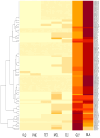Antimicrobial and Phylogenomic Characterization of Bacillus cereus Group Strains Isolated from Different Food Sources in Italy
- PMID: 39335071
- PMCID: PMC11444136
- DOI: 10.3390/antibiotics13090898
Antimicrobial and Phylogenomic Characterization of Bacillus cereus Group Strains Isolated from Different Food Sources in Italy
Abstract
Background:Bacillus cereus is a widespread environmental Gram-positive bacterium which is especially common in soil and dust. It produces two types of toxins that cause vomiting and diarrhea. At present, foodborne outbreaks due to Bacillus cereus group bacteria (especially Bacillus cereus sensu stricto) are rising, representing a serious problem in the agri-food supply chain. Methods: In this work, we analyzed 118 strains belonging to the Bacillus cereus group, isolated from several food sources, for which in vitro and in silico antibiotic resistance assessments were performed. Results: Many strains showed intermediate susceptibility to clindamycin, erythromycin, and tetracycline, suggesting an evolving acquisition of resistance against these antibiotics. Moreover, one strain showed intermediate resistance to meropenem, an antibiotic currently used to treat infections caused by Bacillus cereus. In addition to the phenotypic antimicrobial resistance profile, all strains were screened for the presence/absence of antimicrobial genes via whole-genome sequencing. There was inconsistency between the in vitro and in silico analyses, such as in the case of vancomycin, for which different isolates harbored resistance genes but, phenotypically, the same strains were sensitive. Conclusions: This would suggest that antibiotic resistance is a complex phenomenon due to a variety of genetic, epigenetic, and biochemical mechanisms.
Keywords: Bacillus cereus group; WGS; antibiotic resistance; food poisoning; minimum inhibitory concentration.
Conflict of interest statement
The authors declare no conflicts of interest.
Figures


Similar articles
-
Characterization of the Bacillus cereus Group Isolated from Ready-to-Eat Foods in Poland by Whole-Genome Sequencing.Foods. 2024 Oct 14;13(20):3266. doi: 10.3390/foods13203266. Foods. 2024. PMID: 39456328 Free PMC article.
-
Genetic diversity, antimicrobial resistance and toxigenic profiles of Bacillus cereus isolated from food in Brazil over three decades.Int J Food Microbiol. 2011 May 14;147(1):12-6. doi: 10.1016/j.ijfoodmicro.2011.02.029. Epub 2011 Mar 1. Int J Food Microbiol. 2011. PMID: 21440319
-
Characterization of Bacillus cereus Group Isolates From Human Bacteremia by Whole-Genome Sequencing.Front Microbiol. 2021 Jan 12;11:599524. doi: 10.3389/fmicb.2020.599524. eCollection 2020. Front Microbiol. 2021. PMID: 33510722 Free PMC article.
-
Bacillus cereus Invasive Infections in Preterm Neonates: an Up-to-Date Review of the Literature.Clin Microbiol Rev. 2022 Apr 20;35(2):e0008821. doi: 10.1128/cmr.00088-21. Epub 2022 Feb 9. Clin Microbiol Rev. 2022. PMID: 35138121 Free PMC article. Review.
-
Bacillus cereus sensu lato antimicrobial arsenal: An overview.Microbiol Res. 2024 Jun;283:127697. doi: 10.1016/j.micres.2024.127697. Epub 2024 Mar 18. Microbiol Res. 2024. PMID: 38522411 Review.
Cited by
-
Organic vs. Conventional Milk: Uncovering the Link to Antibiotic Resistance in Bacillus cereus sensu lato.Int J Mol Sci. 2024 Dec 17;25(24):13528. doi: 10.3390/ijms252413528. Int J Mol Sci. 2024. PMID: 39769288 Free PMC article.
-
Identification of Bacillus anthracis Strains from Animal Cases in Ethiopia and Genetic Characterization by Whole-Genome Sequencing.Pathogens. 2025 Jan 7;14(1):39. doi: 10.3390/pathogens14010039. Pathogens. 2025. PMID: 39861000 Free PMC article.
-
Subclinical Mastitis Related to Streptococcus canis Infection in Dairy Cattle.Vet Sci. 2025 Mar 19;12(3):286. doi: 10.3390/vetsci12030286. Vet Sci. 2025. PMID: 40266987 Free PMC article.
-
Genomic and Transcriptomic Profiling of Bacillus cereus in Milk: Insights into the Sweet Curdling Defect.Foods. 2025 Feb 25;14(5):780. doi: 10.3390/foods14050780. Foods. 2025. PMID: 40077483 Free PMC article.
References
-
- El-Arabi T.F., Griffiths M.W. Foodborne Infections and Intoxications: Chapter 29. Bacillus Cereus. 4th ed. Academic Press; Cambridge, MA, USA: 2013.
Grants and funding
LinkOut - more resources
Full Text Sources
Molecular Biology Databases

